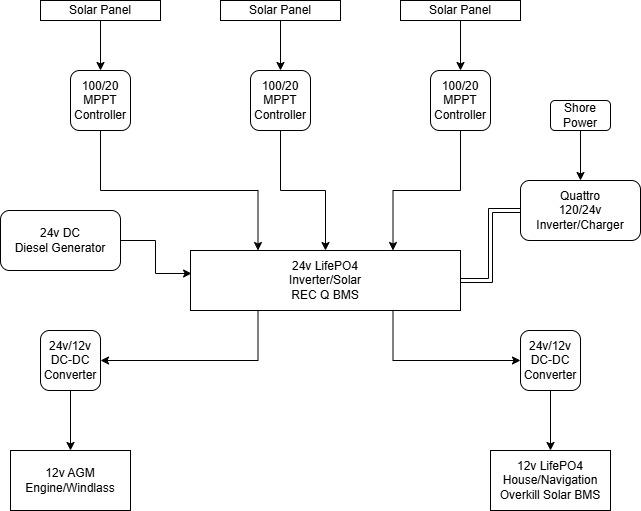Basic Battery systems Design
Madeye has evolved a bit as I've built and refined the system. It suffered some setbacks thanks to some hurricanes, but those were taken as lessons and used to improve the system and design.
Madeye is a 1973 Ericson 46 monohull sailboat. The age of the boat means that she's... suffered from various refits and wiring misadventures of the previous owners. With that in mind, I've been replacing virtually all of the wiring and electrical systems on the boat. As part of this refitting, I've developed.
Madeye currently features THREE battery banks. The Engine/Windlass bank, The Solar/Inverter bank and a House/Navigation bank. Both lithium and AGM battery technologies are used for a combination of capacity and reliability.
The Solar/Inverter bank is a 580 amp hour, 24 volt LifePO4 battery pack. It's managed by a REC Q BMS and delivers power for the inverter (120v power for cooking, laptops, appliances, etc). It's directly charged by three MPPT solar controllers, each with a dedicated panel supplying it. In addition, it supplies 12v power to the house and engine packs via a pair of 24/12 DC-DC converters. This pack CAN be fully depleted without impacting the engine or house systems. It is always charged via Solar, but shore power AND a DC generator can be used as charging sources.
The Engine/Windlass bank is a pair of AGM cells. These require little in the way of maintenance and are very reliable. It is charged from the main Solar/Inverter pack as well as the engine alternator.
The diagram above can be daunting, but in reality it's fairly simple. The large 24v pack is my main large bucket of power. It feeds the two smaller 12v buckets as long as it's full enough. This method ensures that the 12v house/navigation pack (which runs things like anchor lights!) isn't touched until the large pack discharges below my set threshold.
The DC-DC converters in use are Victron Orion Tr-Smart units. They are managed via bluetooth app, which allows them to be configured for various states. In particular, I have them programmed to turn off when the large 24v pack dips below a certain voltage that correlates to around 20-25% charge on the large pack. I may modify this in the future for more accurate control but this method is simple and effective.

